
STOMPer Jeremy says this fire on a forested plot of land in Tampines was so huge, it could be seen by his friend staying in Eunos.
Jeremy said:
"A fire occurred in front of an empty forested plot of land just across the road of Block 714, Tampines Ave 9 at around 4pm on 30 Jan 2009.
"The inferno was quite big, and the smoke generate from it was enormous.
"According from my friend who stays near Eunos area, the columns of brown smoke generated from the fire could be seen from his upper floor flat, more than 10km away.
"My location was nonetheless at the heart of the disaster zone, barely metres across the road from the inferno ground where the fire had destroyed the land slightly larger than the size of a football field.
"I was woken up abruptly from my afternoon nap by the choking smell of the burning trees.
"Upon looking out of the window, I realised that I was surrounded by a thick layer of smoke.
"The next block was barely visible. I know instinctively where the choking smoke could have come from.
"And the likely source was the forested area just metres from my block due to the dry weather season that I had long suspected might have ignited the fire.
"The visibility of the whole neighbourhood and the roads (Tampines Ave 9, Ave 6 and part of Ave 5) directly in the path of the thick black smoke was almost close to zero.
"The heat was intense, bright skies turned into evening and the heat could even be felt across the road where the ferocious fire was raging.
"The fire got stronger and stronger with the help of the North-East strong wind which seemed to be blowing toward the South."
SCDF says it received a call at 4.34pm informing them of a bush fire on a plot of land located at the junction of Tampines Avenue 6 and Avenue 9.
Three fire engines, one red rhino, one tracked fire-fighting vehicle and three support appliances were deployed to the scene.
SCDF arrived at the scene within six minutes.
It says the fire involved overgrown shrubs across an area one and a half the size of a football field.
The fire was extinguished within one hour using six water jets.
No one was injured.
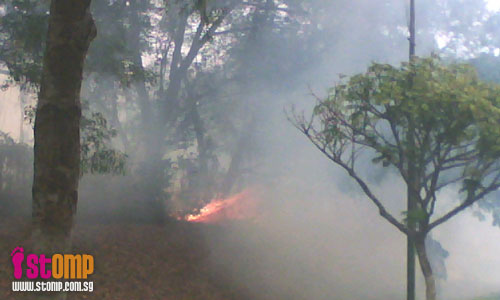

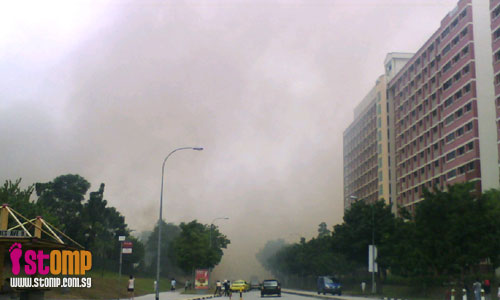
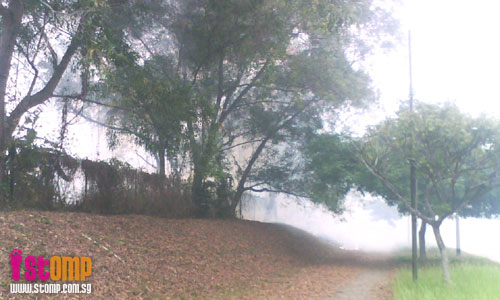
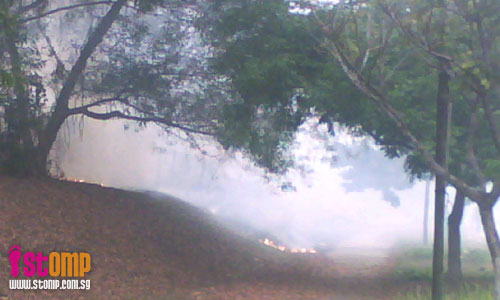
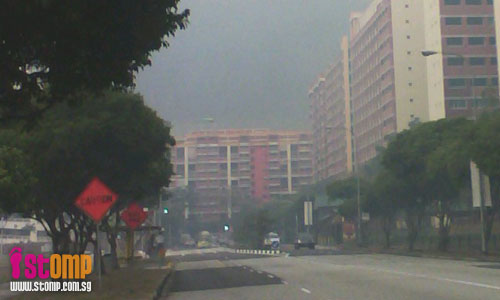
Go here for relevant news articles and related Seen on STOMP posts on bushfires in Singapore
I had no idea there was a bush fire in that part of Tampines yesterday, especially since I live quite nearby, and my workplace is also situated quite close to where the fire occurred. At the time of the fire, I was occupied with other matters in another corner of Singapore, so unfortunately, I missed the chance to watch the smoke from my workplace.
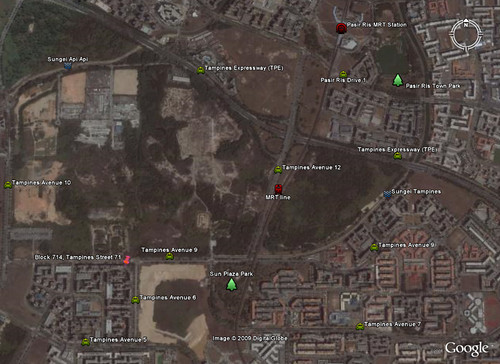
(Click here for original size)
Here's a view of the affected area on Google Earth, showing part of Tampines and Pasir Ris. Block 714 is indicated, as are major roads. You can also see the MRT line between Tampines and Pasir Ris Stations, a couple of parks, and the upper reaches of Sungei Api Api and Sungei Tampines. Also, take note of the large expanse of open land bound by Tampines Avenue 10 on the left, Tampines Avenue 12 on the right, Tampines Avenue 9 at the bottom, and the Tampines Expressway (TPE) on top. I have not personally gone down to check out the site, but this is likely to be where the fire took place. Oh, any by the way, my home and my workplace happen to be somewhere inside this image as well.
When I was 14, and living just along Sungei Tampines, a bush fire broke out in the forested area opposite my block. In the satellite image, that's the slightly smaller, almost triangular piece of open land bound by the MRT line on the left, the concretised portion of Sungei Tampines at the bottom, and the TPE on top. I can't recall if it occurred during the drier months, but it did produce quite a lot of smoke, and it took some time before the firefighters were able to put the fire out. The burned mixture of scrub and grassland remained charred and blackened for some time, and it took at least a couple of years before the regrowing vegetation completely covered all traces of fire.
Many native species inhabit these areas of scrub and grassland, from wildflowers to birds, and it is unfortunate that most of these patches are considered to be of little conservation value. In 2005, a particularly bad spate of bushfires led to the publication of this article in the local papers, about the possible threat to native fauna and flora found in these habitats.
These patches of wasteland are covered with a mixture of scrub, grassland, and Adinandra belukar, and feature a mixture of both native and non-native plant species. In low-lying areas, the ground becomes waterlogged, creating marshes. I have not really intensively explored these areas, but I did make a few forays many years ago when I was in secondary school, only to be stopped in my tracks by forbiddingly impenetrable tangles of lalang (Imperata cylindrica) and giant mimosa (Mimosa pigra).
Although such man-made patches of secondary vegetation might seem impoverished in terms of biological diversity as compared to primary rainforest, The Natural Heritage of Singapore does have some very interesting things to say about them:
"In contrast to primary vegetation, which is in equilibrium with the physical environment of the site, secondary vegetation undergoes ecological succession, a process of continuous, uni-directional change (Corlett, 1991b). In theory, if an area of primeval vegetation is cleared, a series of different vegetation types will succeed one another at the site, culminating in the restoration of the primeval vegetation type originally there if these conditions are met: the physical environment is not irreversibly altered and the constituent species have not become extinct.
In many parts of Singapore, unfortunately, the physical environment has been changed permanently, particularly in the topography, drainage patterns as well as elimination of the original primeval vegetation is not possible without intensive human intervention. Renewed or regular disturbance also reverses any succession towards its endpoint."
In other words, in the past, any land cleared for farming and development and then abandoned, would have eventually reverted to tall secondary forest given enough time. However, because of repeated clearing and disturbance, and the way in which human activity has significantly altered the environment, it is difficult or impossible for the original forest species to recolonise and recreate the original habitat.
Fire has an important part to play, since many of the dominant plant species found in secondary vegetation in Singapore are fire-tolerant or fire-resistant to some degree. For example, lalang dominates some areas, almost to the exclusion of other plants, because its underground rhizomes enable it to survive fires which destroy the shrubs and trees that sprout in these grasslands. Similarly, while Adinandra belukar is normally eventually replaced by tall secondary forest, fire prevents the trees characteristic of tall secondary forest from re-establishing themselves. And so Adinandra belukar forms a new final stage in the process of ecological succession, creating a fire climax habitat.
If anyone is interested in finding out more about how Singapore's natural vegetation has been changed and altered over the years, I highly recommend the following:
- R.T. Corlett, 1991a. Plant succession on degraded land in Singapore. Journal of Tropical Forest Science, 4(2): pp. 151-161.
- R.T. Corlett, 1991b. Vegetation. In: Chia Lin Sien, Ausafur Rahman & Dorothy Tay (eds.), The Biophysical Environment of Singapore. Singapore University Press: pp. 134-154.
- R.T. Corlett, 1992. The Ecological Transformation of Singapore, 1819-1990. Journal of Biogeography, 19(4): pp. 411-420.
- J.W.S. Sim, H.T.W. Tan & I.M. Turner, 1992. Adinandra belukar: an anthropogenic heath forest in Singapore. Plant Ecology, 102(2): pp. 125-137.
- H.T.W. Tan, L.M. Chou, D.C.J. Yeo & P.K.L. Ng, 2007. The Natural Heritage of Singapore. Prentice Hall.
- Y.C. Wee & R.T. Corlett, 1986. The City and the Forest: Plant Life in Urban Singapore. Singapore University Press.